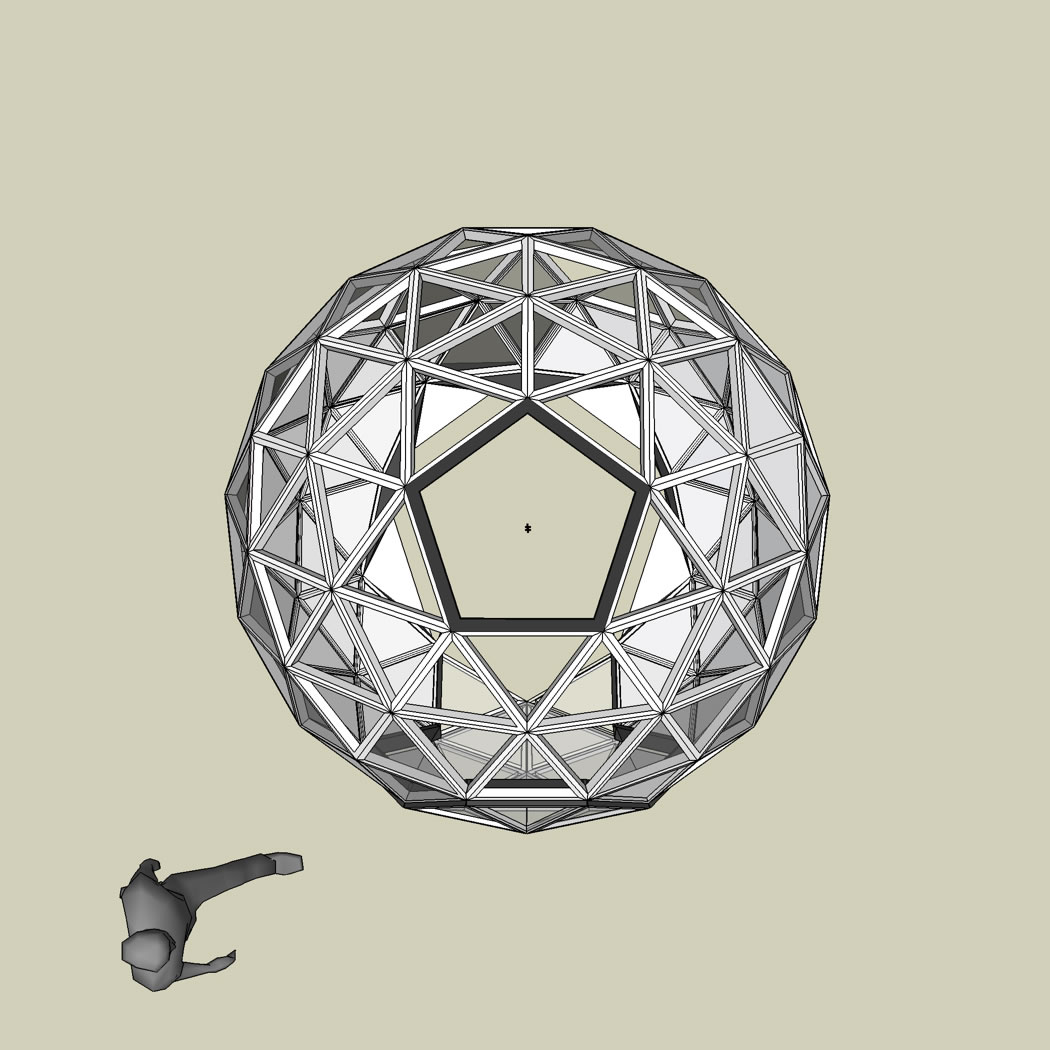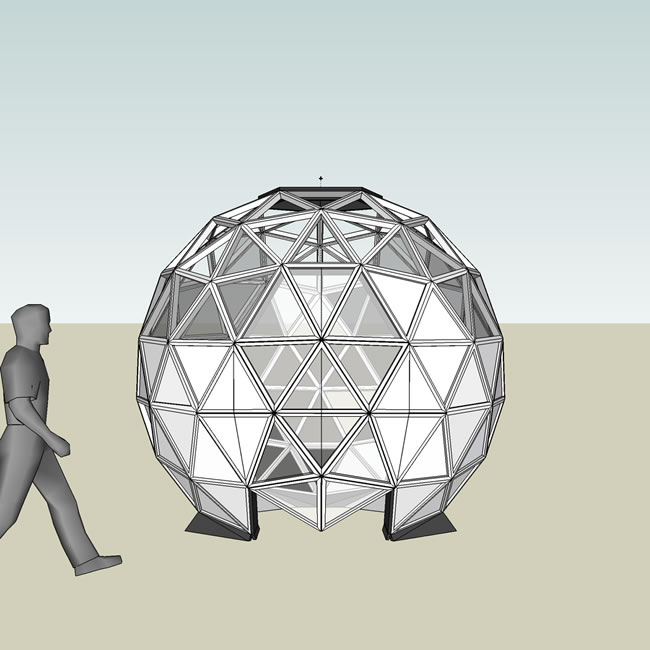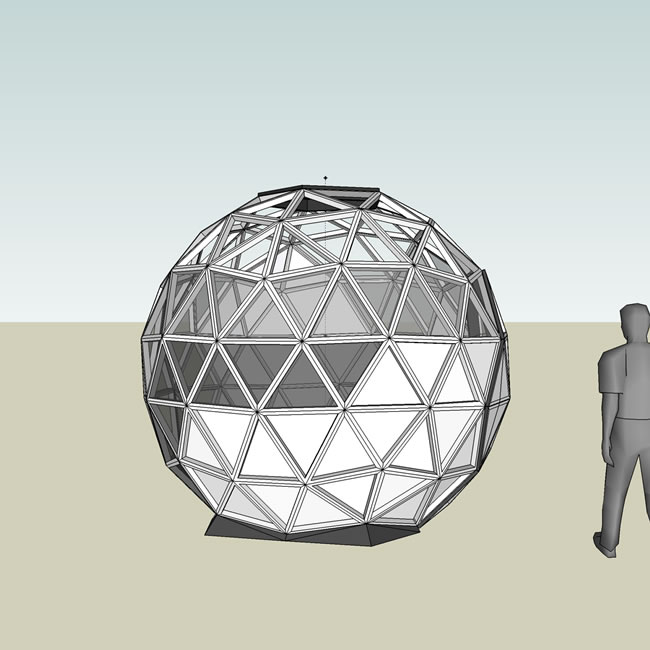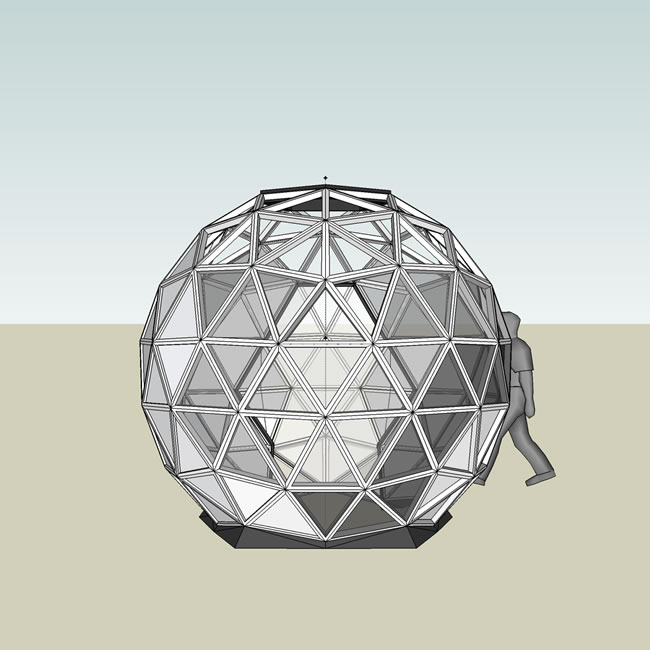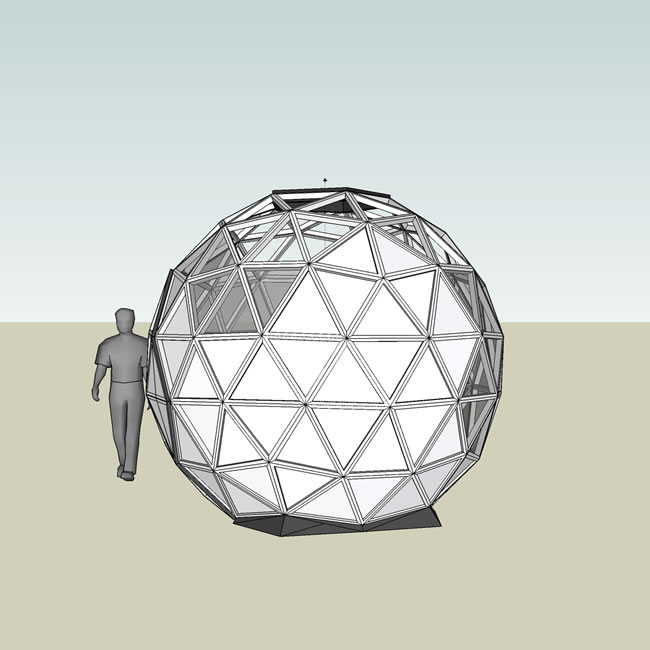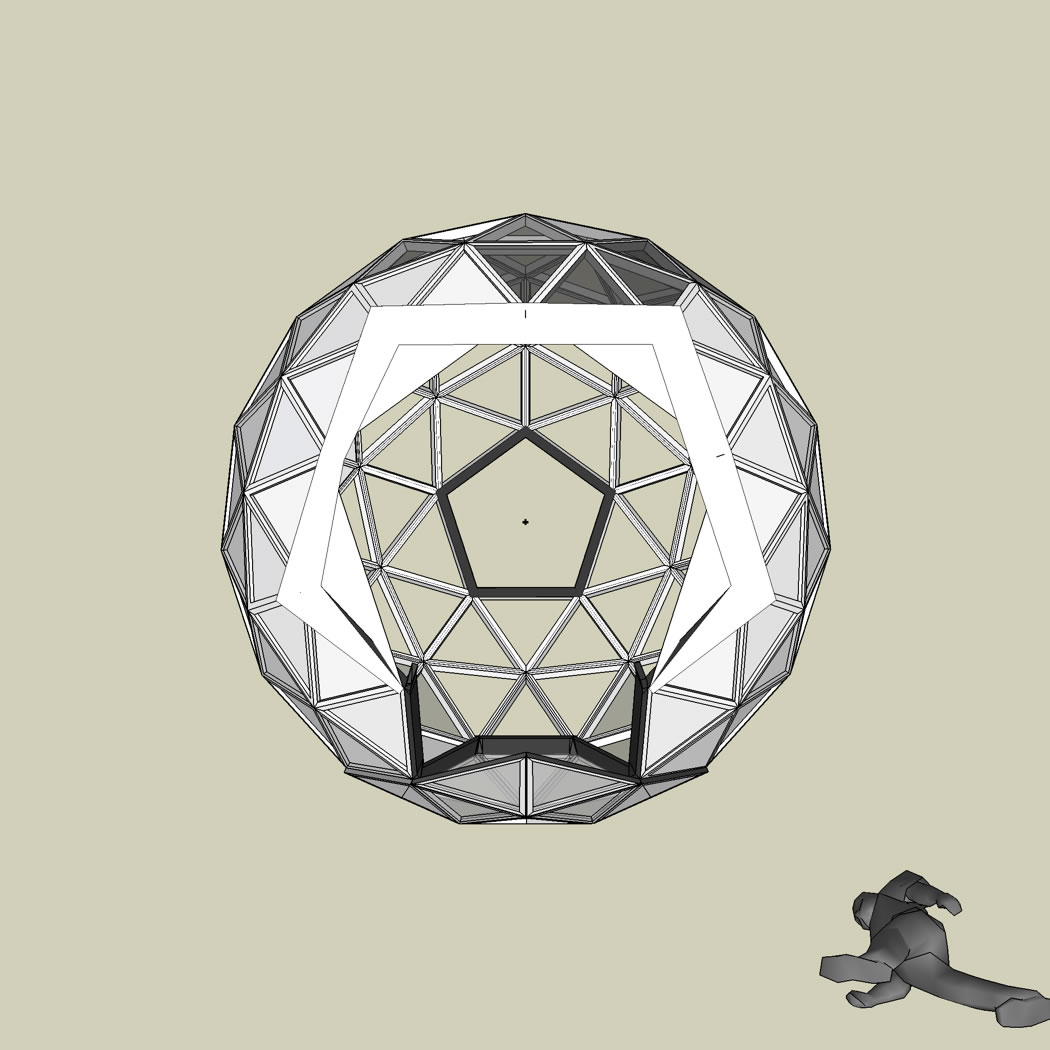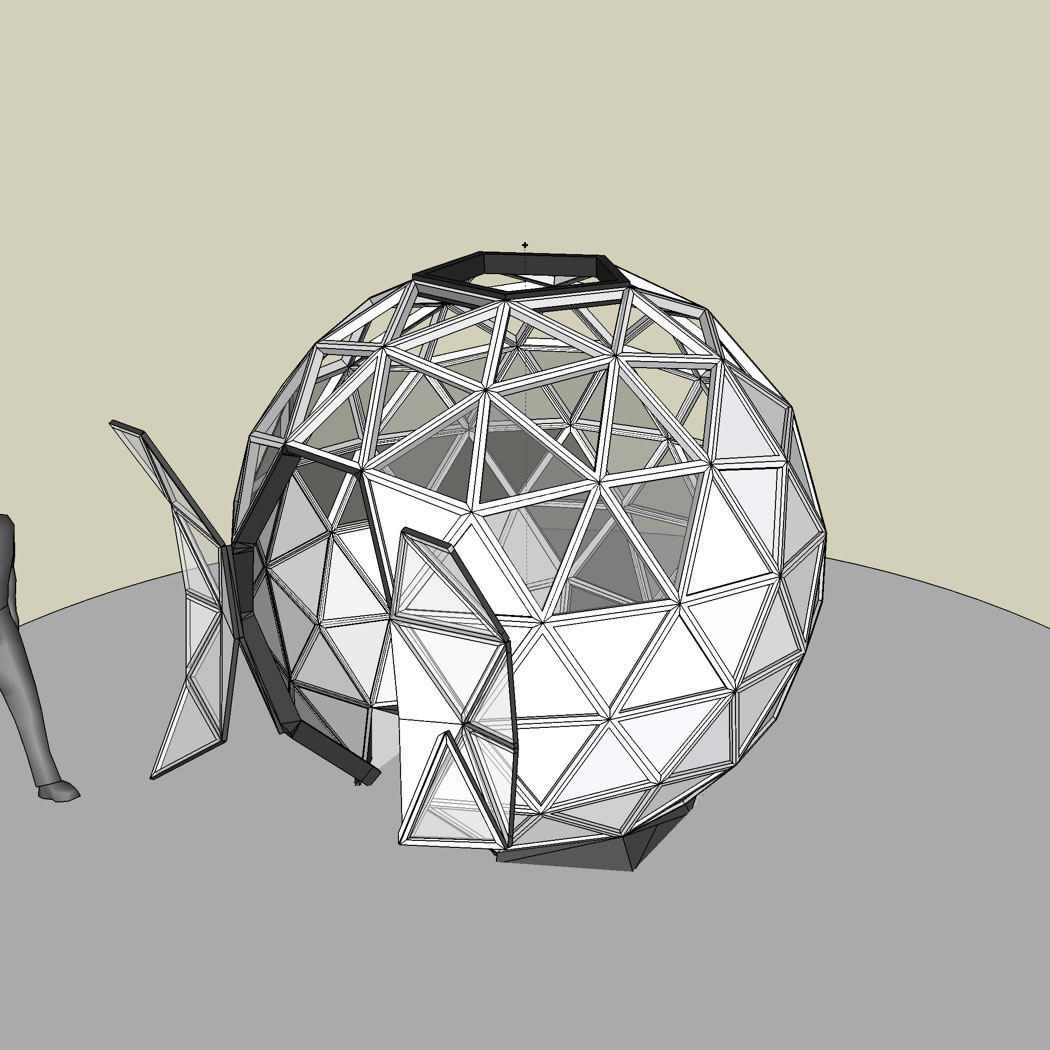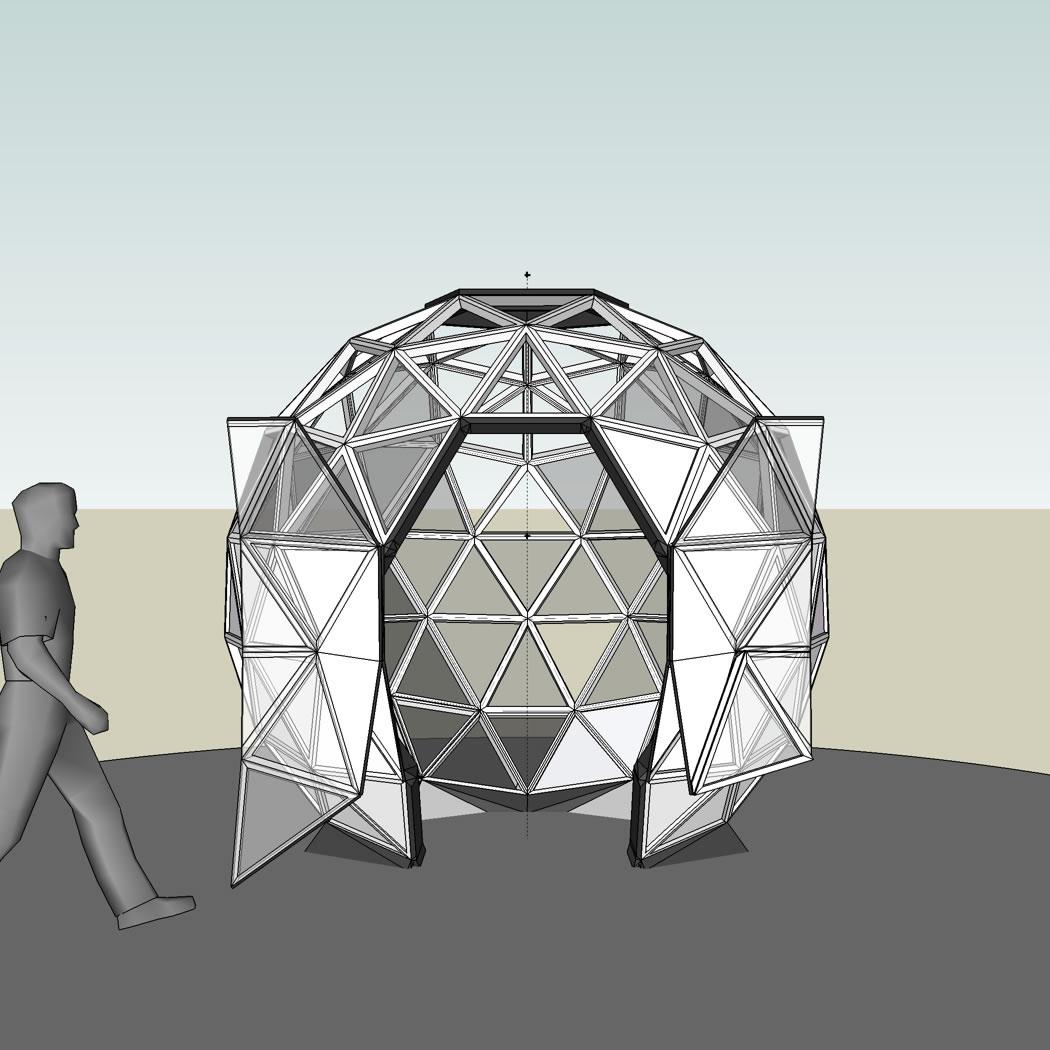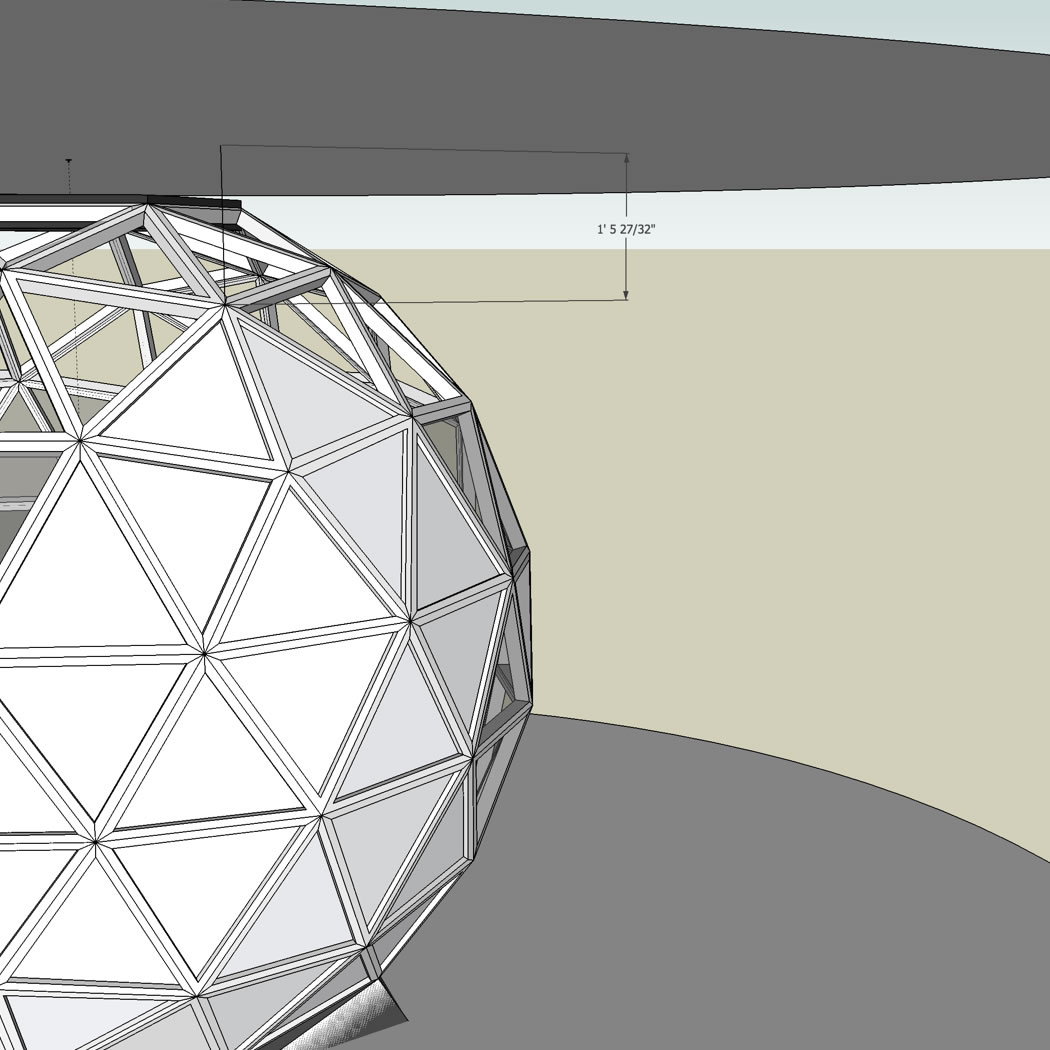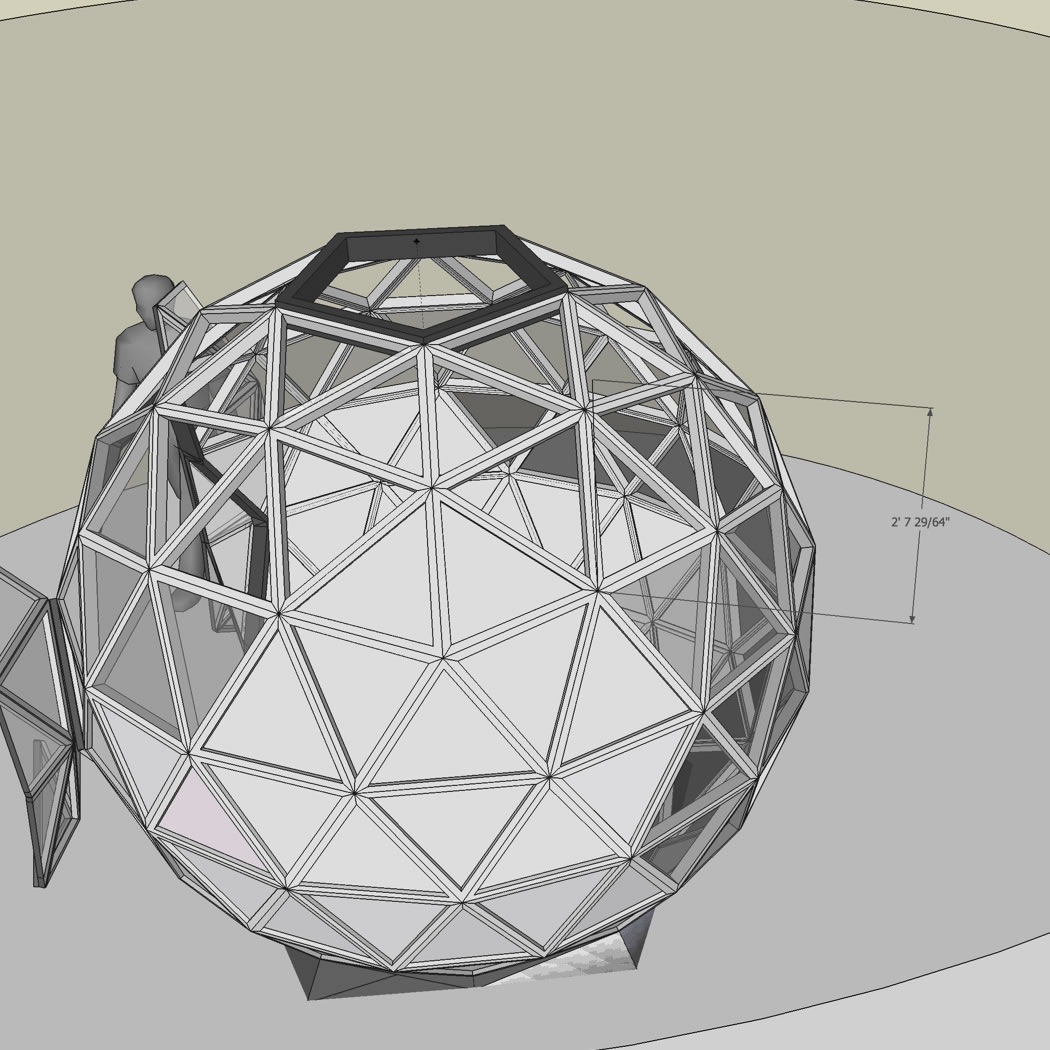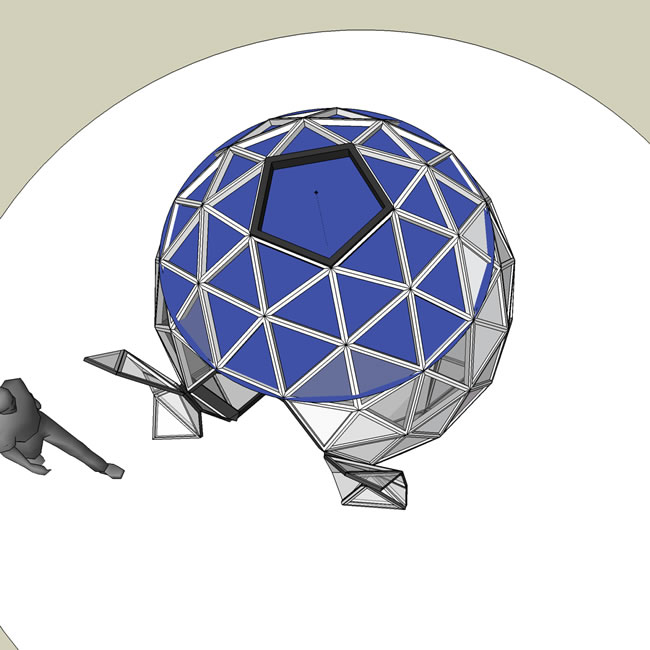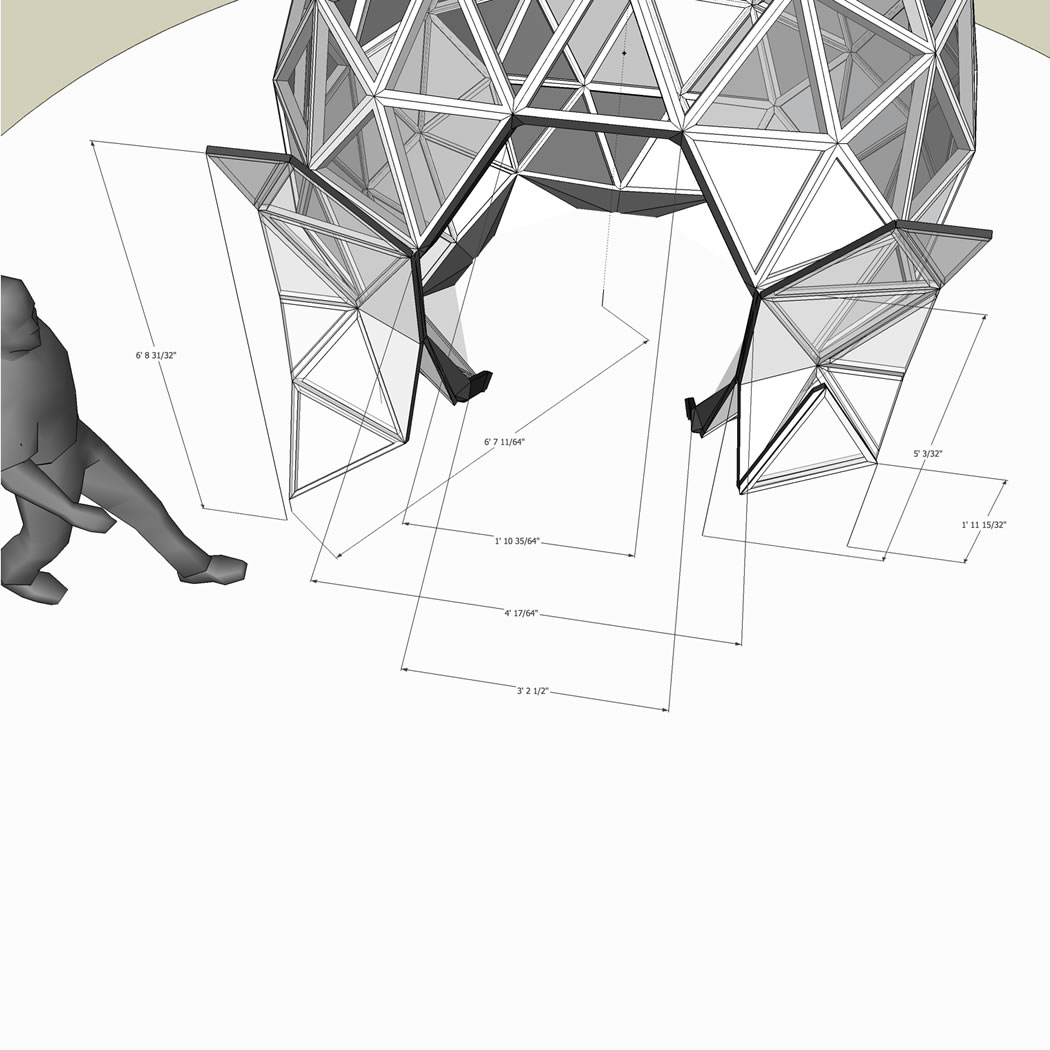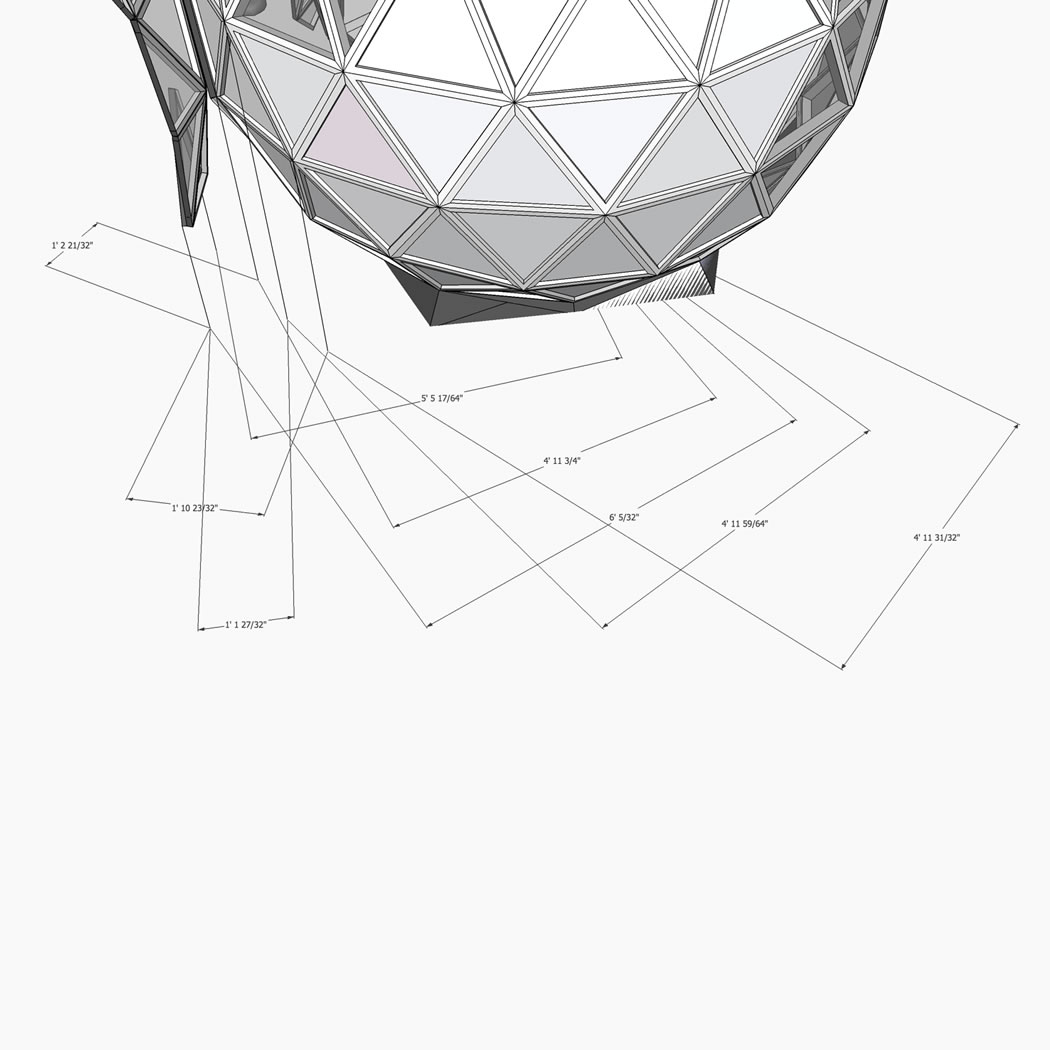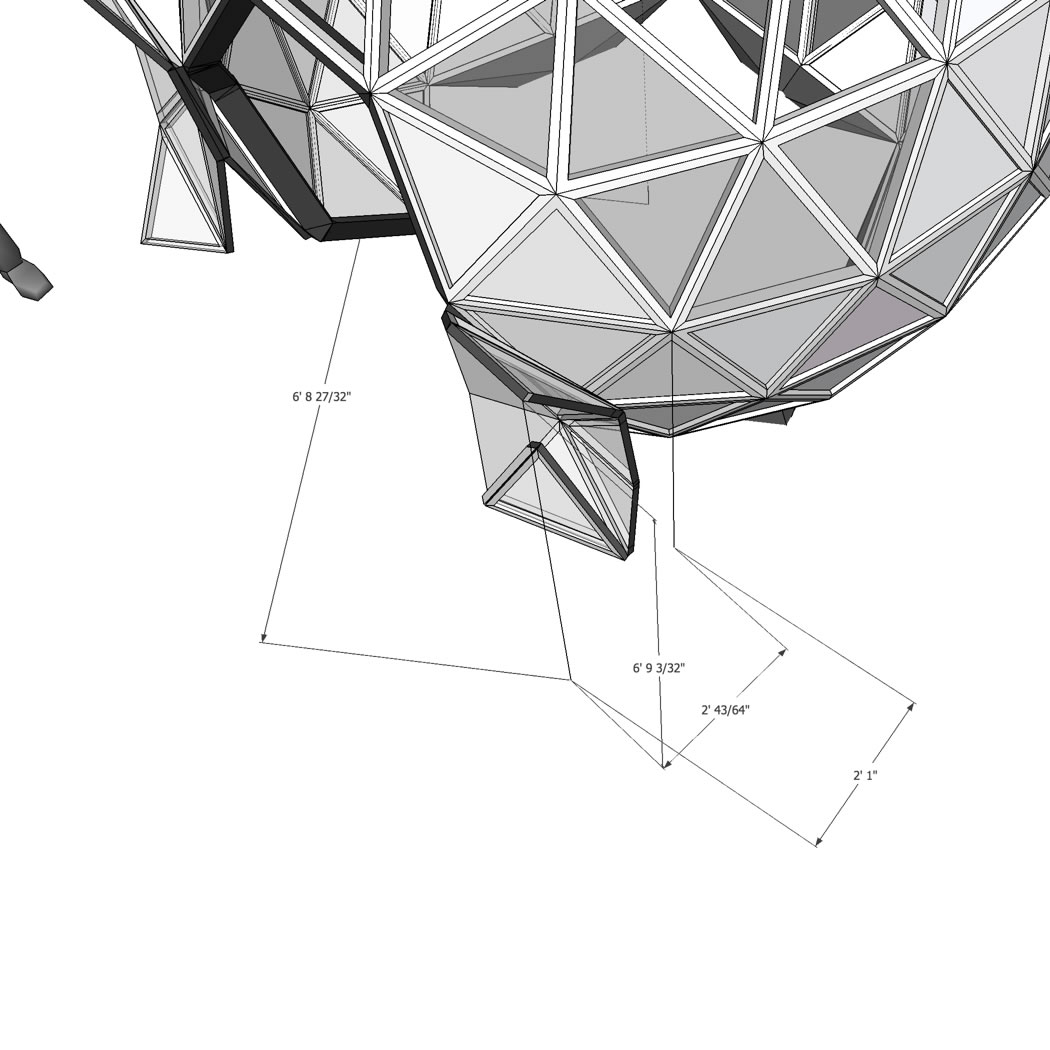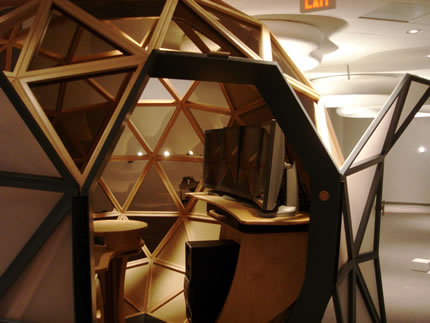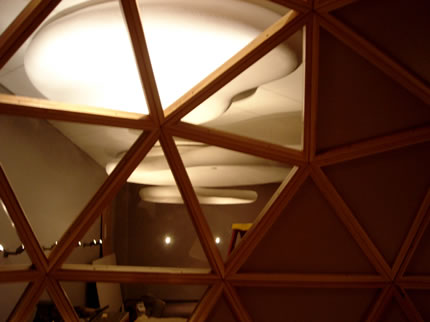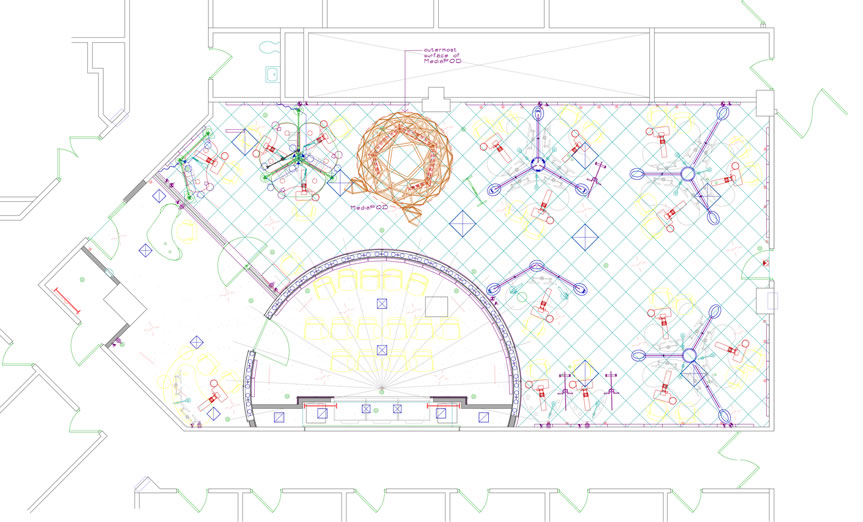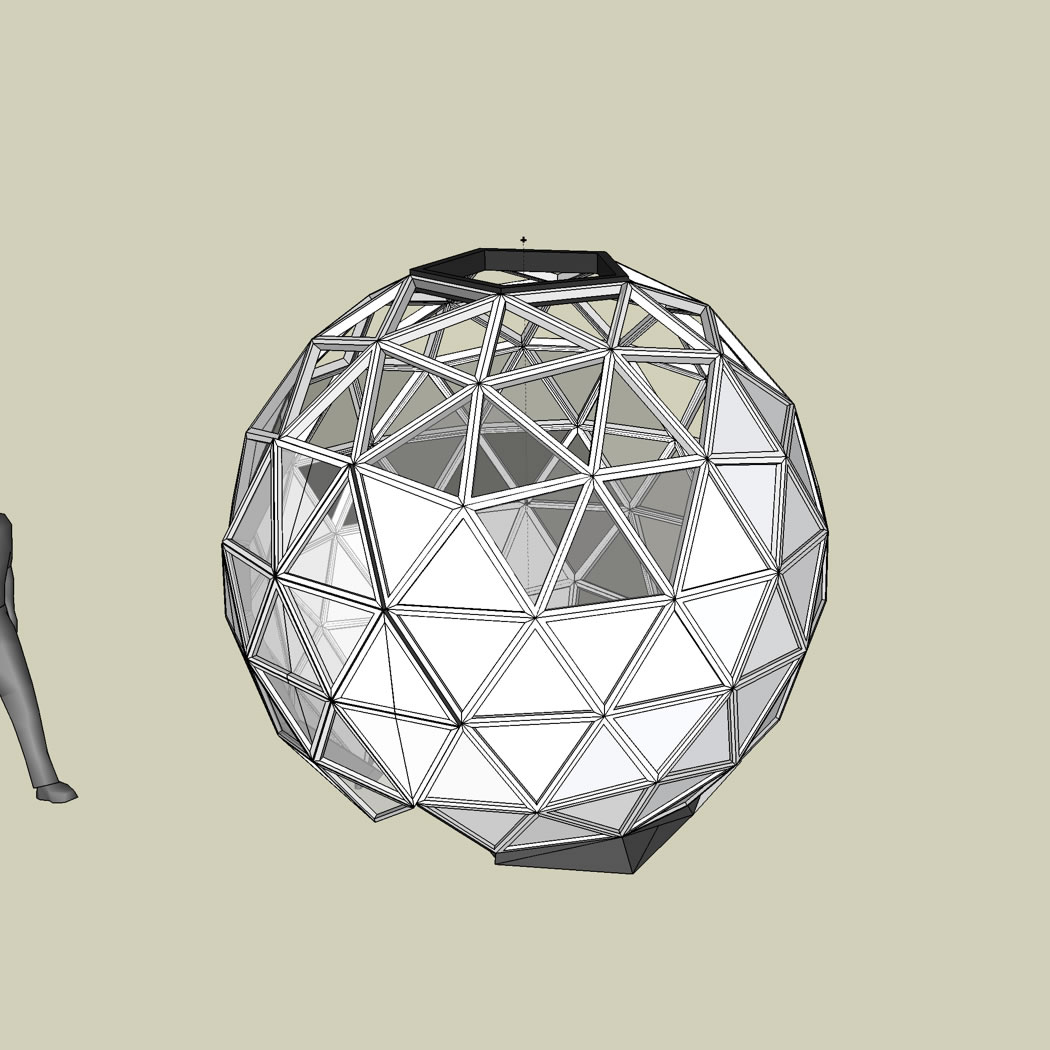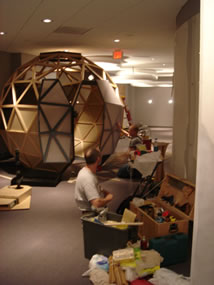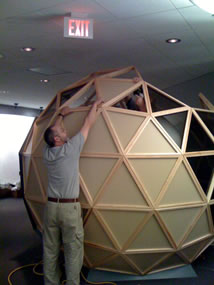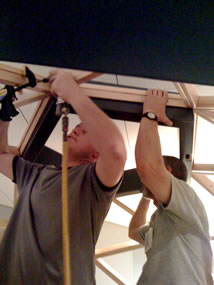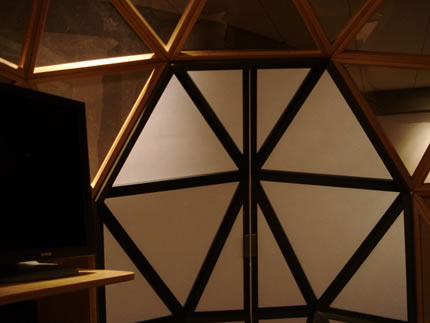ReturnTo: UVA mediaPOD Application Design Build Process |
Gallery of Drawings and Photos with Annotations |
click on drawings to return to UVA mediaPOD Design-Build |
|
note: as can be seen by the photos taken during the first phase of installation of the mediaPOD, during the final fabrication phase small changes were made to the skin (panels, glazing and open triangles) configuration to better fit interior functionality to the Reading Room architecture.
|
3/4 Top From Right View of UVA mediaPOD |
|
| Comments: For enhanced ventilation and to simplify the entry-exit process, the lower two |
These two photos show the the POD doors being fitted at the shop and then after the the outer shell was installed at UVA.
The door structure follows the POD geodesic structure and is painted the same color of the base, door frame and top pent ring. The door skin is made of translucent Plexiglas screwed to the outer frame.
The doors are held in their open and closed position by embedded magnets.
The interior sense of the mediaPOD totally changes between the open and closed states as does the message of inclusion/exclusion delivered to the room at large. |
|
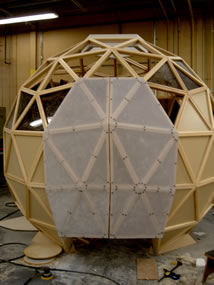 |
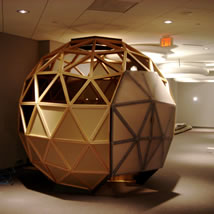 |
| triangles were eliminated in the UVA prototype unit. This decision will be evaluated during the testing period. I like the pattern on the left better however the solution above works best (so far). |
|
Front View of UVA mediaPOD |
|
|
| Comments: This photo and the one above shows the left side view of the mediaPOD as it sits in the Reading Room space. The photos are rotated slightly to the right compared to the elevation. In the install process, the doors are being fitted to the collar which braces the opening in the geodesic structure. The approach to the mediaPOD is a critical design element. There must be clarity in regards how you approach and enter yet a degree of mystery - a sense that there is more to see and understand. |
While still maintaining a s sense of location and place, upon entering the the mediaPOD users will have entered a different world. The approach from the Entry doorway and the ceremony of opening the the POD doors and stepping in the the transition from one reality to another, This is an interface experience. The reverse process is equally important. This design criteria is often overlooked in office spaces. |
|
|
| When a structure can be grasped in its totality in one glance it looses the ability to attract and provide a progression of experiences. A work must be ever varied or it looses presence and meaning. This is particularly challenging in the workplace. |
|
Left Side View of UVA mediaPOD |
|
|
| Comments: There are work stations on both sides of the mediaPOD in this layout. Therefore, most of the glazing is placed on the back of the structure and the majority of this, up to shoulder height, is 50% gray. The view upward over shoulder height is almost totally composed of open triangles, or glazed with a 20% green tint, with the exception of the skin behind the monitors which is made up of solid panels. See 3/4 from right view drawing above. |
This picture is shot from just to the right of the the center of the rear view (see drawing at the left) and from head height looking in. The is actually an impossible view for a user one the space is completed. This is almost over the seating. |
|
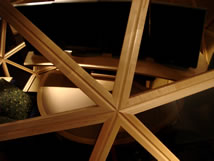 |
| As described below, despite the fact that the areas of greater glazing are close to a solid wall and column, the way that both the room and the mediaPOD is lit will make this area an experience of spatial ambiguity. the interior seating arrangement has it back to this view with a slight orientation to the right toward the main Entry into the Reading Room. See the plan below. This skin design is counter to convention yet an effective design strategy given this mediaPOD’s use, the room and the unique opportunities provided by the geodesic triangular structure and overall form. |
|
Rear View of UVA mediaPOD |
|
|
| Comments: The POD was erected in hexagons and pentagons in a few hours. The tolerances required to do this are extremely small for wood. |
As we developed the interior layout, we shifted the CPU and centerline of the sliding Monitors shelf 36 degrees toward the door. The solid panel configuration on the exterior skin shifted to correspond.
The materials in any triangle (solid, glazing, screening, open or operable panel can be changed at any time. This way, sight lines, ventilation and interior amenity can be adjusted for each POD’s setting.
On the right the top collar is being set. Any inaccuracies will add up to this point. One clamp was required to pull the top ring of hexes to the collar
A fully skinned POD will require a sprinkler head which will drop down through the top collar. This can be embedd in a light fixture. |
|
|
|
|
Right Side View of UVA mediaPOD |
|
Bottom View of UVA mediaPOD |
3/4 View of UVA mediaPOD With Doors Open |
Front View of UVA mediaPOD With Doors Open |
Front View of UVA mediaPOD of highest skin Point To Ceiling - 4 occurrences |
Front View of UVA mediaPOD Establishing Height From ceiling Of Open Hexagons - 26 of 30 |
|
| Comments: The mediaPOD was conceived to be completely enclosed. With the UVA prototype it was decided to leave the POD open there by simplifying sprinkler and ventilation-cooling aspects of this temporary installation. |
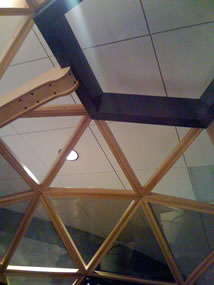 |
| The ceiling tiles run at 45 degrees to the space. This ceiling forms the top of the mediaPOD environment. One pent side is lined up with the ceiling grid as shown on the plan below. This establishes a point of reference, easily seen from the interior, off of which the geodesic geometry then flows. |
|
| The solid and glazed triangles are positioned to both provided a sense of shelter and enclosure while still leaving most of the top open for ventilation and a ceiling mounted sprinkler system. The blue toned area on the left illustrates the degree of openness achieved while the other drawing and picture provided shows the sense of privacy the configuration provides. The geodesic geometry allows exact placement of skin elements in direct response to interior and exterior conditions. |
|
View of UVA mediaPOD Door Dimensions When Open - Front |
View of UVA mediaPOD Door Dimensions When Open - Side |
View of UVA mediaPOD Door Dimensions When Open - Front - Side |
UVA mediaPOD Interior Layout and Functionality: |
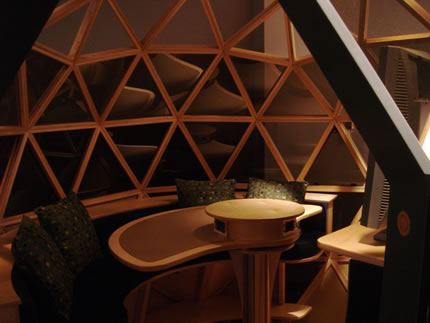 |
The Interior components set up for user feedback. We are going to lower the rotating work top and make a few inches narrower and also lower the monitor shelf by several inches - which pulls away from the outer dome wall to over the work top and swivels several degrees. Plugs, internet connections and dimmer switches will be built into the work top instead of the raised hub shown on the left. Everybody liked the hub however this made the monitors too high. A separate swiveling arm will be provided for a 5ht monitor which is used to access images and display test from dictation. UBS sockets for keyboard and Dictaphone will be built into the monitor shelf. A foot rest and foot pedal space will be built into the base of the work top. |
|
|
| Working with several UVA users and support staff we received feedback on ergonomics, wiring requirements and how the process of analyzing and commenting on the visual data actually works and is filed. Being in the hospital and able to go back and forth between the mediaPOD and existing working stations revealed a great deal of subtitle information which is difficult to convey and understand in another other way. The rotating work surface and the the sliding monitors shelf components were sent back to our AI shop for several modifications. In effect, we had our planned two months review during the install process with feedback and ideas offered by about a dozen people. The wiring of the equipment is far more complex than we imagined it including the fact of how accessible this wiring has to be. Suitable improvements will be made and the units returned for final install by mid May. By this time the room will be finished and the furniture from other manufactures installed. These interior pictures were taken without the entire room lighting system working nor the ten lights on dimmers which we will put into the mediaPOD. The lighting design of this space is one of its strongest attributes. Here there will be shade and shadow a high level of user control of the lighting instead of the usual, bright, fluorescent ceiling providing one uniform visual blight. |
|
|
| This layout of the UVA Radiology Reading Room is a temporary space the purpose of which is to try different ways of designing, building and equipping the larger permanent facility to be built in the near future - this is a prototyping process from materials, to lighting to the furniture. The Architect is Perkins Eastman. Herman Miller and other vendors will supply work stations which can be seen on the plan. The mediaPOD is placed at the narrow part between two sections, each with a different function, of the reading Room. The wall on the left is floor to ceiling translucent; the curved wall at the bottom is made of a LED back lighted floor to ceiling translucent material. A few ceiling lights and many wall mounted spots aimed at the clouds provide ambient lighting for the space. Every workstation provides its own task lighting. |
|
|
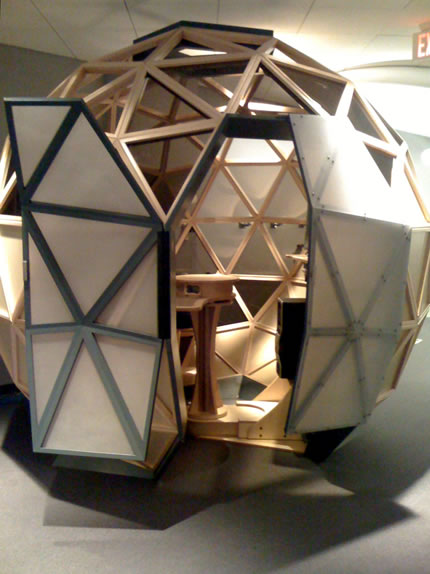 |
With geodesic structures there are always two design challenges which have to be solved both practically and esthetically: the mating of the dome to the floor or ground and the treatment of the doorway [future link]. In this case, we set the dome on a base which conforms to a natural break in the geodesic geometry creating a 2/3 sphere which is a pleasing shape. This creates an intimate foot print inside while allowing maximum width at about waist height where it is most needed. The base is exposed on the inside providing continuity of inside-outside experience. The same materials are used inside and outside for the same reason.
In this application, the doors express the same geometry as the dome and are mounted on the outside of continuous collar which fits the geodesic geometry and structurally compensates for the triangle removed from the dome. The twin door can be configured in four states: both closed, both opened, right door opened, left door opened as shown to to the left each of these configurations alters both the sense of the interior space and the “message” of inclusion and “exclusion” experienced by the POD users and perceived by those in the general environment.
The idea of this application is that several people can sit together, employ the technology analyze data and discuss issues. The process is often done by a single person or maybe two. The mediaPOD provides privacy for this process without entirely removing everyone for the general environment. Just how this will effect the process and use of the technology is something which will be discovered in the coming months. I believe that it will make for an entirely different experience than the traditional set up. This kind of environment should work well for peer consulting, teaching and patient consultation.
The doors are covered with a translucent material to match the walls around the mediaPOD, to be distinct from the rest of the skin and to enhance privacy. |
|
| This view of the mediaPOD is from the wider space on the right hand side of the the plan (above). The curved wall to the left of the POD still has its protective paper over the back lighted translucent wall. When exposed and lit up this will bring an entirely different aspect to the room. The wall at the front of the picture is also translucent and lit by the spot lights which can be seen. The wall opens to the entry room shown on the left hand side of the plan. As can be seen by the drawings (above), it is the rear of the POD which has the most glazing. This may seem confiding at this stage of development yet it will not feel this way |
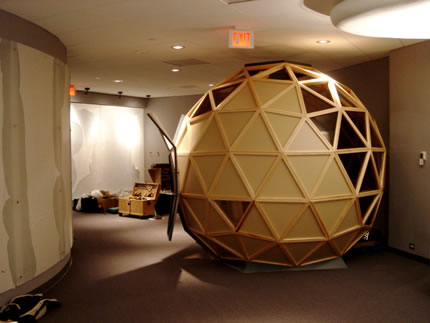 |
|
| when completed. Spots within the mediaPOD will project the geodesic geometry onto the wall and there will be high interior landscaping at both sides of the dome adjacent to the wall. This will create visual “space” between the dome skin and the wall. Light will bounce back illuminating the POD from the outside. These spots will be on a dimmer so the sense of prospect and refuge can be determined by the users. Depending on the brightness level of the ten lights placed in the mediaPOD, interior ambiance and exterior impact can be tuned as desired. The POD will act as background for several of the other open office furniture set ups in the space. While remaining open at the top for code reasons, the mediaPOD functions as “a room within a room.” |
|
| After the installation of the mediaPOD shell, there remains one potential issue and this is how the code inspector will consider the coverage of the ceiling mounted sprinkler system. Different jurisdictions administrate the code differently based on their experience. This issue is why it was decided by UVA to leave the POD open at the top, although the intent of this design is to be an entirely enclosed “room within a room,” instead of running a sprinkler head down into the top of the POD. At the time, the design called for a wood lighting ring which made this difficult. The wood part of this ring has been eliminated making it far simpler to drop a sprinkler if required. Myself, I believe the existing head is ideally positioned to cover the interior of the POD. The drawing “Front View of UVA mediaPOD Establishing Height From ceiling Of Open Hexagons - 26 of 30” indicates this openness although two more triangles have been glazed because of changes in the interior arrangement. As the pictures show, this openness is not perceivable from eye height standing outside the mediaPOD - this is intentional. From inside, the glazing as placed, the use of the existing ceiling as a sheering plane and the POD lighting (yet to be installed) will provide the maximum opening while still achieving the intended sense of enclosure. If this openness - enclosure relationship is altered, then the intention to test the mediaPOD environment in regards its relationship to the work process to which it is employed will be compromised. It may be that the inspector, if guided through the actual circumstance which the configuration artfully disguises, will see that the POD is 90 percent open from its widest point upward and thereby adequately covered by the sprinkler. Perhaps he will request a second ceiling mounting head place more directly above the POD. IF, he requires a dropped head this is easily arranged and should be done (not the reduction in glazing) to keep the integrity of the experiment. In this case, after the drop and head is installed, we can design a casing which will not interfere with its function yet will further enhance the POD-to-ceiling plane relationship which is so critical to the working of this configuration. In this case, the head should be positioned dead center in the top open pentagonal collar and come down to the elevation which satisfies the inspector. Often, codes become the genesis of compromised architecture. I do not believe that this is necessary. There is always a solution which fits all concerns and dialog among team members, which in my mind includes regulatory agents, can lead to happy solutions. In terms of any additional cost related to modifying sprinklers, two aspects should be considered: the cost is trivial compared to the expense of setting up this carefully design environment; and, the intent of this experiential is to find out which configurations work best for each equipment configuration and work-task-processes. For the intent of this project to be accomplished, the best setting and configuration should be provided for each of the furniture pieces being tested. |
|
| The mediaPOD interior will have to be adapted for each different kind of use. This application, for Radiology viewing, is one of the most demanding in terms of ergonomics and technology integration making this an idea prototyping opportunity. |
|
|
| The work of MG Taylor, TMA and AI is to integrate environment, technology and work processes to enhance performance, collaboration and transformative thinking and action. Like all environments we build - large and small - this is the mission of the mediaPOD. |
|
|
posted: February 19, 2008 • revised: May 17, 2008 |
|
